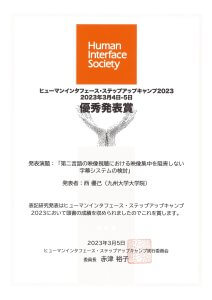国際ジャーナル「ACM IMWUT」に1件採択
2023年4月4日 最終更新日時 : 2023年4月25日 jinchoi

国際ジャーナル「Proceedings of the ACM on Interactive, Mobile, Wearable and Ubiquitous Technologies (ACM IMWUT)」に下記1件の論文が採択され、3月28日にて出版されました。
Yugo Nakamura, Rei Nakaoka, Yuki Matsuda, Keiichi Yasumoto
eat2pic: An Eating-Painting Interactive System to Nudge Users into Making Healthier Diet Choices Journal Article
In: Proceedings of the ACM on Interactive, Mobile, Wearable and Ubiquitous Technologies, vol. 7, iss. 1, no. 24, pp. 1-23, 2023.
@article{imwut2023-nakamura,
title = {eat2pic: An Eating-Painting Interactive System to Nudge Users into Making Healthier Diet Choices},
author = {Yugo Nakamura, Rei Nakaoka, Yuki Matsuda, Keiichi Yasumoto},
url = {https://app.ait.kyushu-u.ac.jp/wp-content/uploads/2023/04/3580784.pdf},
doi = {10.1145/3580784},
year = {2023},
date = {2023-03-28},
urldate = {2023-03-28},
journal = {Proceedings of the ACM on Interactive, Mobile, Wearable and Ubiquitous Technologies},
volume = {7},
number = {24},
issue = {1},
pages = {1-23},
abstract = {Given the complexity of human eating behaviors, developing interactions to change the way users eat or their choice of meals is challenging. In this study, we propose an interactive system called eat2pic designed to encourage healthy eating habits such as adopting a balanced diet and eating more slowly, by refraining the task of selecting meals into that of adding color to landscape pictures. The eat2pic system comprises a sensor-equipped chopstick (one of a pair) and two types of digital canvases. It provides fast feedback by recognizing a user's eating behavior in real time and displaying the result on a small canvas called "one-meal eat2pic." Moreover, it also provides slow feedback by displaying the number of colors of foods that the user consumed on a large canvas called "one-week eat2pic." The former was designed and implemented as a guide to help people eat more slowly, and the latter to encourage people to select more balanced menus. Through two user studies, we explored the experience of interaction with eat2pic, in which users' daily eating behavior was reflected in a series of "paintings," that is, images produced by the automated system. The experimental results suggest that eat2pic may provide an opportunity for reflection in meal selection and while eating, as well as assist users in becoming more aware of how they are eating and how balanced their daily meals are. We expect this system to inspire users' curiosity about different diets and ways of eating. This research also contributes to expanding the design space for products and services related to dietary support.},
keywords = {},
pubstate = {published},
tppubtype = {article}
}
Given the complexity of human eating behaviors, developing interactions to change the way users eat or their choice of meals is challenging. In this study, we propose an interactive system called eat2pic designed to encourage healthy eating habits such as adopting a balanced diet and eating more slowly, by refraining the task of selecting meals into that of adding color to landscape pictures. The eat2pic system comprises a sensor-equipped chopstick (one of a pair) and two types of digital canvases. It provides fast feedback by recognizing a user's eating behavior in real time and displaying the result on a small canvas called "one-meal eat2pic." Moreover, it also provides slow feedback by displaying the number of colors of foods that the user consumed on a large canvas called "one-week eat2pic." The former was designed and implemented as a guide to help people eat more slowly, and the latter to encourage people to select more balanced menus. Through two user studies, we explored the experience of interaction with eat2pic, in which users' daily eating behavior was reflected in a series of "paintings," that is, images produced by the automated system. The experimental results suggest that eat2pic may provide an opportunity for reflection in meal selection and while eating, as well as assist users in becoming more aware of how they are eating and how balanced their daily meals are. We expect this system to inspire users' curiosity about different diets and ways of eating. This research also contributes to expanding the design space for products and services related to dietary support.


